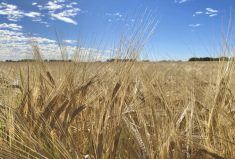*[Updated with email comment at bottom: Aug. 25, 2017] The key to branding any product is to start with a good story, and the recently re-instated registration of OAC21, a six-rowed malting barley, is a “feel good” story, particularly with Canada’s 150th anniversary in 2017.
On its own, OAC21 isn’t expected to ever become a huge opportunity for Ontario farmers, but maybe it doesn’t have to get grown on a massive acreage to rate as a big story.
The research that produced OAC21 dates back more than 100 years, and its rebirth today comes with the craft brewing sector as its primary market. First released in 1923, it was developed from a single seed of the Mandscheuri variety in 1903.
Read Also

Producers aren’t panicking over tariffs and trade threats
The influence of tariff and trade uncertainity on farm business decisions.
Until the 1970s, it was the leading variety of malt barley grown primarily in Ontario and across Canada. Its progeny include AC Metcalfe, CDC Copeland and Bentley, among others.
In 2002, the barley breeding program at the University of Guelph obtained OAC21 seed, along with other Eastern Canada varieties, for a demonstration plot showing how today’s new varieties compare against older seed. The plot clearly showed that advances have been made in yield, lodging and disease resistance, as well as maturity levels.
But of all the barleys in this demonstration plot, OAC21 was the only one suitable for malting, and it caught the attention of maltsters and brewers in their search for a heritage variety.
From there, the university’s barley breeding program began producing sufficient volumes of OAC21 for commercial-scale malting. That work was done in 2016, with a 30-fold increase in yield in spite of excessively dry conditions. Seed was then sent to California for further production last fall with the harvested and cleaned seed then going for production in Alberta on 40 to 50 acres, sufficient for commercial malting at Canada Malting in Thunder Bay.
Good news story?
Again, it’s an interesting story, not without a few twists and turns. For the record, the vast majority of malt barley is grown in Western Canada, then shipped east (Ontario only produces roughly 5,000 of the 300,000 tonnes grown in Canada each year).
Canada Malting liked what it saw in OAC21, however, and asked that it be developed as a heritage variety, and now, as the primary breeder overseeing OAC21’s reinstatement, Dr. Duane Falk likes the growing “good news” angle that comes with it. He also made the featured presentation to the Ontario Cereal Crops Committee to push for the reinstatement for registration in January 2017.

“Canada Malting saw it and its value. They are the ones who pinpointed it as the variety they wanted to run with, and they have paid the costs of multiplying it up,” says Falk, professor emeritus and cereal breeder at the University of Guelph. “I understand their viewpoint… I wish there was more of an Ontario take on it, but they want to grow it in the West where they’re quite sure they’ll be no disease, and we can’t really object to that.”
Falk only wants to see the finished malt product made available in Eastern Canada, and he doesn’t think the demand will be so great in this half of the country that it will hinder Canada Malting’s demand in the West. The other hope on his part is that interest in OAC21 would drive the development of one or two other varieties with the “heritage” stamp on them. But for the time being, OAC21 will be the big story.
Limited opportunity
Despite its heritage demand, growers shouldn’t expect a huge mark-up in the price per bushel, something that Falk would like to see. Older varieties, he notes, don’t have the same strengths as other varieties for Canada Malting, Rarh Malting and others. Consistency is key in brewing, and brewers, like millers with wheat, have standard preferences from which they refuse to deviate. Bentley, Copeland and Newdale are today’s industry standards, and in spite of other varieties that might yield more, brewers want what they’re familiar with in order to maintain their flavour profile.
“It takes about five years before brewers become comfortable with a variety,” says Falk, adding that larger-scale brewers tend to be conservative in their approach. “The craft brewers — not so much. But with Molson’s, Labatt’s and Sleeman’s, once they have something that works, they don’t want to change it because that would change a brand’s flavour.”
It’s to the point where from one year to the next, there are subtle changes in the way a particular variety might grow, due to growing or harvest conditions. That’s why the maltsters prefer to buy more than they need in a given year. That way, they can hold back some of one year’s selection to blend with the next year’s batch, reducing variability and maintaining the consistency of the flavour. In fact, notes Falk, brewers will often blend two or three batches to find that consistency.
Yet it’s that inconsistency or variability that craft brewers seek. And to be clear, it doesn’t take a lot of so-called heritage malt to make it a “heritage” craft beer.
It all spells opportunity for a few growers, not many. Falk maintains that it will be a niche market opportunity, although it may open up that niche for other barley varieties, as well.
It’s also worth noting that OAC21 is not only attractive to smaller craft brewers — Molson is also a customer, again taking full advantage of a heritage malt coinciding with Canada’s sesquicentennial festivities.
“OAC21 has such a good long story, and there are so many people who want to capitalize on that story, that I think that’s where it will capture some of that market,” says Falk. “These old varieties aren’t far off the mark — if they’re handled well. But I also think that expectations have to be reduced — I think farmers are going to have to be paid a premium for the yield penalty — and there is one.”
Falk believes there must be a premium on older varieties. “My concern is that the maltsters want a certain type of barley, so they will put criteria on it,” says Falk, adding that if it doesn’t have a certain test weight or germination, they will reject it. “And that’s the risk that the farmers are taking. Some of these older varieties won’t make the grade quite as often as some of the newer ones, plus there’s the yield factor.”
Looking to the future
It’s one of the more unique properties of agriculture: rarely is anything entirely lost. Old chemistries or old varieties will always find a new use somewhere, somehow. That’s the “foot-in-the-door” that Falk is counting on finding. OAC21 represents an “off-the-shelf” opportunity, i.e. something already in existence that can be plugged into the value chain to create a new market opportunity.
Now, the longer-term goal is to find other varieties — with other traits — and adapt them to conditions and markets here.
“We want to find out where we can get material that’s pretty close to the target to begin with,” says Falk. “We hope to find something quickly and get it out. In the meantime, we’ll be feeding material into the breeding programs, and right now the programs in Eastern Canada are starting to focus more on malting barley as well, because they see it as an opportunity.”
*Ralph, sorry for not contacting you sooner about the OAC 21 barley article from earlier this month but I do want to point out a couple of “errors” in the article.
1. The statement “Until the 1970s, it was the leading variety of malt barley grown primarily in Ontario and across Canada.” is a considerable overstatement. By the 1970s (and even in the late 1960s) OAC 21, while likely still showing up on barley variety lists for western Canada as did a number of other minor varieties of the day, was nothing more than a footnote in history as it had been replaced by vastly superior and more widely grown 6 rowed varieties Conquest and Bonanza and even the 2R variety Betzes at a time when the vast majority of Canadian barley acreage was of the 6 rowed type. I started working in the barley industry here in the 1970s and having toured many malting and brewing facilities at that time never once saw a barley or malt lot identified as OAC 21 while Conquest and Bonanza were always there until they were gradually replaced by 2 rowed varieties like Klages, Harrington etc. in the 1980s.
2. Another incorrect implication in the article refers to “Its (OAC21) progeny include AC Metcalfe, CDC Copeland and Bentley, among others.” From a plant breeding viewpoint, while technically correct if you go back far enough in the pedigree of these varieties you will find a cross made with OAC21, this doesn’t mean that anything specific from OAC21 actually remains in these newer varieties. In fact one could argue that during the many cycles of breeding that have gone into these newer varieties since the point at which OAC21 shows up in their distant pedigree means that today’s breeders have gotten rid of whatever OAC21 might have provided.
The implication that OAC21 had any significant genetic input into these newer varieties is again an overstatement. Self pollinated plant breeding (as is the case for barley) is not the same as animal breeding in that plant breeders have the luxury of producing many, many thousands of progeny from each crossing and then selecting among those for traits from either parent. This selection in fact might result in only a very small contribution from one of those parents moving forward in the breeding history of subsequent progeny with further and further dilution of that contribution as successive crossing is done with those selected progeny.
I trust these comments will be taken in the constructive manner with which they are intended.
Brian Rossnagel, SOM, FAIC, FCSA, Ph.D., P.Ag.
Distinguished Professor Emeritus
Barley & Oat Breeding
Crop Development Centre
University of Saskatchewan
Saskatoon, Saskatchewan S7N 5A8
Canada
















